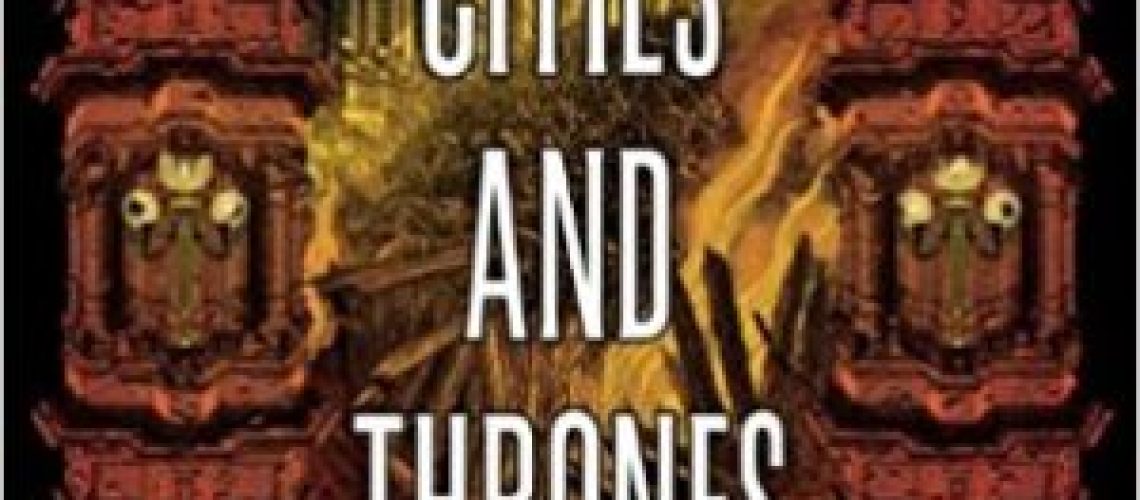Revolt and revolution are only the beginning of the troubles facing Malone, Jane and the other characters in CITIES AND THRONES, the follow-up to THE BURIED LIFE by Carrie Patel. Taking place on the heels of the prior book, while the first novel is a New Weird murder mystery with a large side of political revolution and unrest, Cities and Thrones explores the consequences, causes and calamities when political revolution happens.
Malone has prospered, in a way, in the wake of the political changes occurring in the prior volume, having risen to a position of power and authority over the Inspectors that she didn’t quite want, but is the only person trusted for the job, anyway.
Jane Lin and her companion Anders, on the other hand, having gone on the run, give the reader a view into a completely different city — Medina. While Medina is another underground city in the same vein as Recoletta, its culture and setup are very different. Lin’s talents for espionage and getting wrapped up in the councils of power do not fail her in Medina, and Lin soon finds herself caught in them in her new city in short order.

The strength and the weakness of Cities and Thrones, for me, is precisely the same thing. The first novel had a foregrounded murder mystery that drew Inspector Liesl Malone and a background of political intrigue and revolution, the latter building until coming to a head in the climax of the novel. That novel might have balanced the narrative a bit too much toward the murder mystery for my taste, leaving me wanting to know more about the world and how it worked, and why.
By comparison and contrast, the matter of Cities and Thrones very much is signaled by its title. This novel is almost entirely espionage, political intrigue and political maneuverings, within Recoletta, Medina and elsewhere. Malone does have investigations to run, but those investigations are much more of a political bent and origin. No more are the days of simple murder mysteries, not when Malone is answerable, and reports directly to, the head of the new regime. Cities and Thrones explores this tension adroitly, showing the pressure Malone is under in a position and doing the kind of things that she never really signed up for, but now is bound to do for the sake of order and society.
Lin’s arc, too, is entirely wrapped in politics and intrigue, as a position she gains in Medina puts her at an intersection of power, influence and visibility that makes herself a target, pawn, and mover of politics. She is agent, spy, and broker and grasper for power and influence in a foreign city. It is well that she is far less of a relative ingenue and innocent caught in conspiracy; here she is still young, and caught on the horns of power and those who would use her, but she has far more agency than in The Buried Life. And we get some wonderful contrasting worldbuilding in the newly seen city of Medina, seeing how much it is alike to Recoletta … and how it is extremely alien and different.
This is all a two-edged sword, though. For better or worse, the murder mystery in The Buried Life gave the novel a skeleton and a roadmap of a plot on which the author hung her worldbuilding, politics and everything else. That skeleton was sometimes too thick, and the things hung on it too thin for my taste sometimes, but it was an effective template nevertheless. Without that murder mystery as a skeleton, this novel has something of a structure problem. The politics, machinations and worldbuilding here are all fabulous, and better than the first novel. We get to see more of how the world works, inside and outside the cities. We get to see how things *don’t* work when there is a break and a change, and we get to see how political revolutions lead to a lot of knock-on effects, both within and without.
It’s all fascinating and interesting, and the aftermath of the revolution in Recoletta puts me in mind of some of the events of the French Revolution. Thus, the tangle of events here reminds me strongly of the novels of Django Wexler and Brian McClellan, especially when the plots of their novels focus on intrigue and city adventure rather than the flintlock fantasy war scenes. These three authors, McClellan, Wexler and Patel, all understand and illustrate that revolution and political upheaval are never, ever, smooth and easy affairs. There are countervailing forces, revanchist forces, radical elements, and the ordinary person *still* has to muddle along and live the day-to-day life, sometimes in a very broken world.
However, in Cities and Thrones, there is something missing without that murder mystery to serve as a template for the plot, and a pacing mechanism for the reader to feel things ratcheting up to its conclusion. There are strands of events happening, but the novel really feels the lack of the more overt plotting in the first novel. That said, the last portion of the novel, and the denouement, are extremely well done, and it does show that for the author, there has been intricate plotting all along, and all the way back to the first novel. However, the appearance of that intricacy is not what it could have been in most of the second novel.
The ending of Cities and Thrones opens up many possibilities for a third volume. While the structural problems of the novel are significant, I am still well invested in Recoletta, and its characters. Thus. while hoping for some more overt framework in it, I would be interested in seeing further development of this world and the people that inhabit it from the author’s keyboard.








One Response